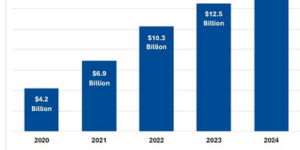A hard market combined with underwriting capacity from fronting companies allowed for robust growth in the MGA market in 2023, according to a new Conning strategic study.
The global investment management firm’s 11th annual study on the P/C program business market explains the study’s use of the term “MGA” is generally meant to capture distribution firms that operate with some degree of delegated authority from an insurer or capital provider. Conning includes the following in its property/casualty program business universe: (1) MGAs (managing general agents), (2) MGUs (managing general underwriters), and (3) PAs (program administrators, also known as program managers).
The U.S. MGA market exceeded $80 billion in premium in 2023, growing by 13 percent (compared to P/C premium growth only growing 10 percent).
MGA premiums written by U.S. insurers accounted for approximately 9 percent of total P/C direct premiums of $959 billion, according to Conning’s analysis.
The size of the MGA market has nearly doubled since 2018.
The dynamic sector of the P/C industry is seeing continued and consistent growth with more than 1,000 MGAs.
(Editor’s Note: The $80 billion-plus estimate is based on an analysis of insurer statutory filings identifying P/C direct premiums written in 2023 produced by MGAs. The report notes, however, that for the statutory filings, MGA premium must be reported by insurers only for those MGAs responsible for producing 5 percent or more of the insurer’s surplus. There are many smaller MGAs producing less than this, and Conning estimates that the premium identified through required statutory reporting represents roughly 85 percent of total MGA premium. Therefore, Conning puts the total MGA market at around $102 billion, including $7.5 billion of premium sourced by U.S. MGAs for Lloyd’s.)
Insurance company-fronted MGAs had led premium market share up to 2023. But in 2023, non-affiliated and affiliated MGAs each captured 45 percent of the market share.
Lloyd’s remains the largest single capacity provider for U.S. MGAs.
M&A activity involving the acquisition of U.S. MGAs, MGUs, program administrators or wholesalers slowed in 2023, the study found. There were 39 acquisitions, down from 61 the previous year.
Niche MGAs can be attractive to a larger MGA, with the ability to acquire product expertise and talent while gaining efficiency.
According to Conning, a key factor supporting continued growth and opportunities within the MGA market is the growth in the E&S market over the past five years, highlighting the demand for specialized coverage and underwriting expertise. E&S insurers have absorbed demand resulting from disruptions in the admitted markets, “garnering significant support and capacity by reinsurers and providing stability and balance within some markets” the study noted.
MGAs already eyed for their agility and ability to build technology to their needs, are embracing AI to gain competitive advantage while improving their operations and optimizing expenses.
Employees jump ship from traditional insurers to MGAs, and MGAs are using recruiters to find specialized talent.
According to Conning, “The entrepreneurial character of many MGAs is a draw—offering the excitement of a startup environment along with equity incentives.
MGAs also offer greater flexibility, often allowing employees to work remotely.
The report included the results Conning’s 9th annual independent survey of MGAs, MGUs,
and program administrators—adding insurers (including fronting companies) and reinsurers to the mix for the first time. Among the survey findings: 89 percent of insurers responded said they are expanding their use of MGAs. Reasons insurers gave include growth opportunities, specialty lines opportunities, accessibility of business through MGA distribution, and nonadmitted platforms.
Survey participants also expressed confidence in the ability of MGAs to continue to thrive under softer market conditions.
MGAs will continue to be an area of interest due to their niche specializations, said Conning, and the market growth is expected to continue to outpace the P/C market.





















 Wildfire Losses Increasing But Still Small Compared to Hurricanes: KCC
Wildfire Losses Increasing But Still Small Compared to Hurricanes: KCC  Is State Farm General Too Big to Fail? Calif. Rate Hearing Concludes
Is State Farm General Too Big to Fail? Calif. Rate Hearing Concludes  The Future of the Insurance Customer Experience Is Unity, Personalization
The Future of the Insurance Customer Experience Is Unity, Personalization  Lemonade: 700K Customers on the Car Waitlist
Lemonade: 700K Customers on the Car Waitlist 
